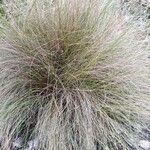Coarse, dense, green or blue-green often very scabrid tussocks, to c. 120 cm, with a large bulk of dead dry leaves densely packed at the narrow base; branching intravaginal; leaf-blades persistent. Leaf-sheath light greenish brown, later grey-brown, rarely slightly purplish, subcoriaceous, ± distinctly ribbed, ± minutely scabrid. Ligule 0.2-0.6 mm, truncate, minutely ciliate, abaxially scabrid. Leaf-blade 35-65 cm × 1.8-3 mm, coriaceous, flat, to folded and ± inrolled, abaxially usually scabrid, occasionally almost smooth, adaxially finely ribbed, finely scabrid on ribs; margins obviously scabrid, tip ± acicular, straight-sided. Culm 60-110 cm, erect or drooping, internodes scabrid below panicle. Panicle 10-25 cm, open; branches fine, not drooping, slightly spreading, finely scabrid, in clusters of 3-7, naked and undivided below, with numerous spikelets clustered at tips. Spikelets 3-7 mm, 3-5-flowered, light green, often purplish. Glumes usually ± equal, 1.5-3.5 mm, 3-nerved, often scabrid near tip and on midnerve and margins, narrow-to ovate-lanceolate, acute. Lemma c. 2-4 mm, 5-nerved, oblong-elliptic, obtuse, ± short scabrid but usually softly hairy on midnerve and lateral nerves near base. Palea 2-3.5 mm, keels scabrid in upper ⅔ and smooth below, interkeel scabrid. Callus with long tuft of soft tangled hairs. Rachilla slightly > 0.5 mm, minutely scabrid with some longer hairs; prolongation sometimes twice as long. Lodicules 0.5-0.6 mm. Anthers 1-2 mm. Caryopsis 1-1.5 × 0.5-1 mm.
More
Caespitose perennial. Culms 30–130 cm high; mid-culm internodes slightly scabrous immediately below node. Young shoots intravaginal. Leaves: basal sheaths with margins free, glabrous, sometimes slightly scabrous, sometimes purplish; ligule 0.3–0.5 mm long, truncate, apically ciliolate, abaxially puberulous; blade flat, folded or inrolled, 15–61 (–80) cm long, 0.6–3.5 mm wide, ±stiff, adaxially scabrous to puberulous, abaxially antrorsely scabrous or rarely smooth, sometimes glaucous. Panicles open, 10–26 cm long. Spikelets 4.7–6.8 mm long, with 3–5 bisexual florets. Glumes 3-nerved; lower glume 2.6–3.8 mm long; upper glume 3.2–4.3 mm long. Web usually well-developed (very rarely vestigial or absent). Lemma ±oblong in profile, 2.5–4.7 mm long, 5-nerved; midnerve and lateral nerves usually villous in lower half (rarely nerves glabrous); intercostal regions usually glabrous, rarely sparsely puberulous. Anthers 2–2.4 mm long.

